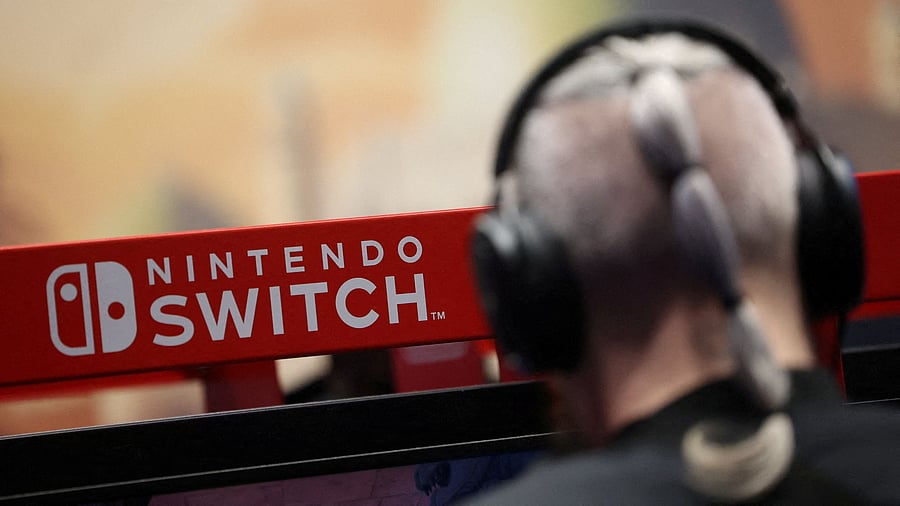
An attendee uses a Nintendo Switch game console while playing a video game.
Credit: Reuters Photo
By Gearoid Reidy
After all the rumors and years of anticipation, we know what Nintendo Co.’s next console is. It’s the Switch - 2.
Admittedly, that might be disappointing to those expecting something more unusual. But the rumors of such a machine had been circulating online for so many weeks that Thursday’s announcement came as little surprise. That online leaks scored not only the machine’s name, but also its logo and color palette, will be infuriating to an incredibly protective company. But in the grand scheme of things, it matters little. What comes next is key.
The Switch 2 announcement contained precious little real information. The new machine will seemingly function much like the original: a hybrid device operating as both portable and console. Nintendo’s showcase video depicts an original Switch morphing into a slightly larger, somewhat more grown-up and less colorful Switch 2 model. The one standout difference emphasized was its seemingly magnetic controllers. Oh, and that release date, or lack thereof: “2025” — not “spring 2025,” not “summer 2025” — a curious choice that raises more questions than it answers.
In truth, the Switch 2 reveal didn’t force Nintendo’s hand at all. Beyond a glimpse of what might be a new Mario Kart, no games were shown in its videos. (This strategy had also been leaked online beforehand.) An April 2 showcase will surely reveal more — and the Kyoto firm has a good record of keeping its in-house games under wraps.
Switch 2 is the simplest branding structure Nintendo has ever done. Go back through its console naming to date: There’s no “2” in sight. (Yes, pedants, I’m aware of the Super GameBoy 2.) The NES became the Super NES; the GameBoy was followed by the GameBoy Advance. Nintendo usually eschewed the obvious decision; most often, it changed things completely, moving from Nintendo 64 to GameCube, from Wii U to Switch. I wondered last year if Nintendo would choose “2,” “Pro,” “Super Switch” or something else entirely.
Yet it’s understandable why Nintendo has chosen this path. Investors have long argued the company should smooth out its console cycle by aping how the iPhone locks users in for a set number of years before forcing them to upgrade, even as Apple Inc. releases a new model annually without fail. Nintendo’s rival PlayStation recently celebrated its 30th anniversary but has moved from PlayStation 1 to PlayStation 5 without ever worrying about the naming conventions, or if consumers thought a new offering was different.
Nonetheless, Nintendo has often fiercely resisted this path. To a fault, the firm usually seeks to surprise — from motion controls to unnecessary 3D screens. The late President Satoru Iwata, speaking before the launch of the Switch, discussed the need to “surprise” gamers rather than rely merely on existing hardware. The Switch has been Nintendo’s standout success. With seemingly no major hardware difference or controller innovation, is sticking a “2” at the end enough?
To be fair, no one is more experienced in this than Nintendo. It followed up the smash hit of the Wii with the Wii U, its greatest-ever misfire. In a case-study marketing failure, the company failed either to differentiate the Wii U from its predecessor or make a case for new users to buy in. As gamers went elsewhere, Nintendo spent years in the wilderness.
The firm will have learned from that disaster. And to a great extent, it really doesn’t matter. The most important thing about Thursday’s announcement was what it didn’t show and what every single console launch depends on: the games.
Here, Nintendo holds all the ace cards. The Switch’s software lineup has been strategically planned over the past few years, leveraging the console’s user base to elevate second-tier properties instead of relying on its standby hits. That’s why there hasn’t been a new Mario Kart in a decade or a new 3D Mario game since 2017. If Nintendo can provide those two titles — along with perhaps Metroid Prime 4, an upscaled version of Zelda: Tears of the Kingdom, and a few smaller titles and re-releases of classics — it could coast to an easy year, one during which demand for the new console will easily outstrip supply anyway.
That buys Nintendo time to wow gamers — and investors. But it shouldn’t coast for too long. The original Switch made its name thanks to a Zelda game (Breath of the Wild) that both stunned and captivated audiences with its originality. The successor hardware might share a name, but it will likely need something similarly captivating if it is to last half as long.